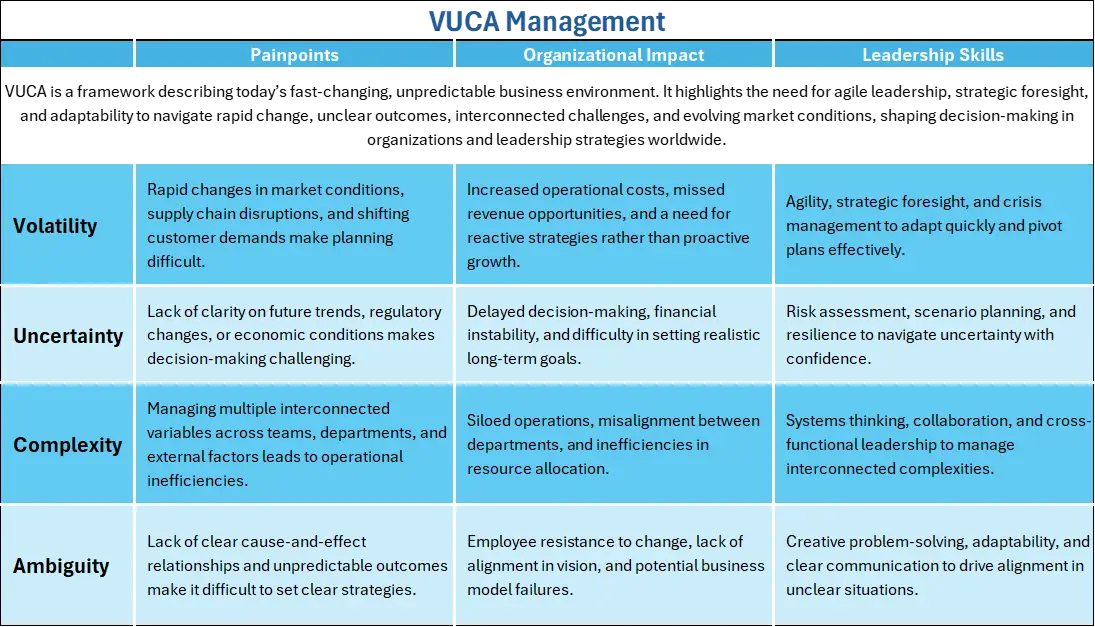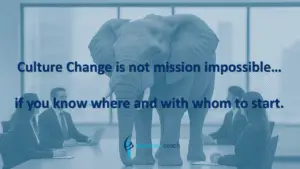The VUCA survival guide for managers

Navigating the VUCA workplace: a survival guide for (middle) managers
In today’s workplace, change is the only constant. Leaders and managers face unpredictable shifts in market demands, technological disruptions, and complex team dynamics. To make sense of these challenges, organizations worldwide use the VUCA framework—Volatility, Uncertainty, Complexity, and Ambiguity.
While VUCA was initially a military term, it is now a widely adopted business framework that helps managers and leaders develop strategies to navigate an ever-changing landscape. Many successful organizations, from global enterprises to startups, have implemented VUCA-based leadership training to equip their teams with resilience and adaptability.
But how does VUCA really affect middle managers in their daily work? Let’s break it down with real-life management problems and practical solutions to help navigate VUCA successfully.
1. Volatility: managing rapid and unpredictable changes
The challenge:
Volatility refers to sudden and unexpected changes that disrupt the status quo. As a middle manager, you may experience this when:
- A key employee suddenly resigns, leaving a gap in your team.
- A supplier fails to deliver, impacting production schedules.
- Corporate strategy changes overnight due to market shifts.
Real-life middle management example:
Sarah, a production manager in a retail company, was informed that a key supplier went bankrupt. This meant delayed product deliveries during peak shopping season. She had to find an alternative supplier within days while ensuring minimal disruption to customers.
Impact on organizations:
- Increased stress on teams and leaders.
- Rising operational costs due to last-minute problem-solving.
- Loss of customer trust and revenue from supply chain instability.
How to manage volatility successfully:
✅ Agility & crisis management: Adapt quickly to changes by having backup plans and flexible workflows.
✅ Proactive leadership: Anticipate risks and create contingency plans for key business operations.
✅ Empowered teams: Train employees to be adaptable and take initiative during sudden changes.
2. Uncertainty: making decisions with incomplete information
The challenge:
Uncertainty arises when you lack sufficient information to predict the outcome of a situation. It happens when:
- Your industry undergoes sudden regulatory changes, but no one knows the full implications.
- Your company is considering a major restructuring, and you don’t know if your team will be affected.
- You must launch a new initiative with no clear market data to support the decision.
Real-life middle management example:
John, a marketing team leader, was tasked with developing a strategy for a new product launch, but customer preferences were unclear due to shifting trends. With limited data, he had to decide how to allocate the marketing budget while minimizing risks.
Impact on organizations:
- Delays in decision-making, leading to missed opportunities.
- Fear of making mistakes reduces innovation and creative problem-solving.
- Stress and low morale among employees when uncertainty lingers.
How to manage uncertainty successfully:
✅ Scenario planning: Develop multiple strategies based on different possible outcomes.
✅ Resilience & adaptability: Accept that not all decisions will be perfect—learn to pivot when needed.
✅ Transparent communication: Keep your team informed, even if you don’t have all the answers. Uncertainty feels less daunting when leaders acknowledge it honestly.
3. Complexity: juggling too many interconnected variables
The challenge:
Complexity comes from interconnected factors that make decision-making difficult. Middle managers often struggle with:
- Cross-functional projects that involve multiple departments with conflicting priorities.
- Balancing hybrid workforces, managing both remote and in-office employees effectively.
- Implementing digital tools, while ensuring the team adopts them successfully.
Real-life middle management example:
Lisa, a customer service manager, needed to implement a new CRM system across three different teams. Each team had different workflows and resisted the new software. Managing IT integration, employee resistance, and training timelines was overwhelming.
Impact on organizations:
- Slow progress due to team misalignment and siloed communication.
- Inefficiencies caused by overcomplicated processes.
- Resistance to change leading to project failures.
How to manage complexity successfully:
✅ Systems thinking: Look at the big picture and identify which factors influence each other.
✅ Cross-functional collaboration: Align departments early to avoid conflicting priorities.
✅ Clear processes & simplification: Reduce unnecessary complexity and ensure employees understand why changes are happening.
4. Ambiguity: leading without clear guidelines
The challenge:
Ambiguity occurs when there is no precedent or clear solution to a problem. It is common when:
- A company enters a new market without established business models.
- The company culture is changing, and employees feel uncertain about leadership expectations.
- A manager must navigate office politics without clear rules.
Real-life middle management example:
Mark, a regional sales manager, was promoted to lead a team in a new international market where customer behavior was vastly different from what he was used to. There were no clear benchmarks, and he had to figure out how to drive sales without a set strategy.
Impact on organizations:
- Employees hesitate to take initiative for fear of making mistakes.
- Teams waste time waiting for absolute clarity instead of experimenting.
- Decision paralysis slows down company growth.
How to manage ambiguity successfully:
✅ Encourage experimentation: Test different approaches and learn from small failures.
✅ Develop a growth mindset: Accept that ambiguity is part of leadership—stay flexible.
✅ Clarify what you can control: Even in uncertain situations, define clear short-term goals to guide the team.
Why VUCA leadership matters now more than ever
The VUCA framework is no longer an abstract concept—it’s the reality of modern business. Successful organizations are investing in leadership training to help managers and teams:
✔ Develop resilience in uncertainty.
✔ Foster agility to pivot when needed.
✔ Improve collaboration across complex networks.
✔ Enhance decision-making in unpredictable environments.
Companies that embrace VUCA leadership succeed in thriving under pressure. Are you equipping your team with the skills to handle today’s challenges?
Closing: how I help leaders navigate VUCA successfully
Closing: How I Help Leaders Navigate VUCA Successfully
Understanding VUCA is one thing—developing the skills to thrive in it is another. That’s where VUCA leadership coaching, training, and keynote speaking come in.
As a leadership coach, trainer, and keynote speaker specializing in VUCA leadership, I work with executives, middle managers, and teams to:
✅ Master VUCA leadership skills—agility, resilience, decision-making, and strategic foresight.
✅ Develop high-performing teams in unpredictable, high-pressure environments.
✅ Transform organizational challenges into opportunities for innovation and growth.
My Approach
🔹 One-on-One Executive Coaching: Tailored coaching to help leaders develop VUCA-ready mindsets and strategies.
🔹 Customized VUCA Training for Organizations: In-house workshops and programs designed to help teams manage uncertainty, complexity, and change.
🔹 Interactive Workshops & Masterclasses: Real-world case studies, simulations, and practical tools to equip managers with immediate strategies to lead through VUCA.
🔹 Keynote Speaking at Conferences & Leadership Events: Engaging and thought-provoking speeches on how to lead in a VUCA world, packed with real-world insights, leadership strategies, and inspiring case studies.
Who I Work With
🔹 Organizations struggling with market disruptions and internal resistance to change.
🔹 Leaders transitioning into new roles who need to develop strategic foresight.
🔹 Teams that need to build resilience and collaboration in fast-moving environments.
🔹 Event organizers looking for a compelling keynote speaker to energize and inspire audiences on VUCA leadership.
The Impact
Organizations and leaders who have engaged with my coaching, training, and keynotes report:
✔️ Faster adaptation to change.
✔️ Stronger leadership alignment in complex environments.
✔️ Improved decision-making under uncertainty.
✔️ A more resilient, engaged workforce.
✔️ Energized and inspired leadership teams ready to take action.
Let’s Talk About Your VUCA Challenges
If you or your organization are facing VUCA-related challenges, let’s connect!
💡 Want to develop VUCA-ready leaders in your company?
🎤 Looking for an engaging keynote speaker to bring fresh leadership insights to your next event?
📩 Reach out to me to discuss custom coaching, training, or speaking engagements tailored to your needs.
🔗 Let’s turn uncertainty into opportunity! 🚀
You can contact met here




